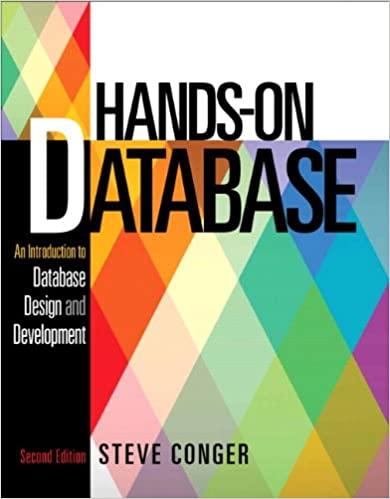Answered step by step
Verified Expert Solution
Question
1 Approved Answer
Array.h #ifndef ARRAY_H #define ARRAY_H #include #include #include #include Iterator.h namespace ds { namespace it { template class Iterator : public IteratorInterface { private: T*

Array.h
| #ifndef ARRAY_H | |
| #define ARRAY_H | |
| #include | |
| #include | |
| #include | |
| #include "Iterator.h" | |
| namespace ds | |
| { | |
| namespace it | |
| { | |
| template | |
| class Iterator : public IteratorInterface | |
| { | |
| private: | |
| T* data; | |
| int cnt; | |
| int capacity; | |
| public: | |
| Iterator() : Iterator(NULL,0) {} | |
| Iterator(T* data,int capacity) : data(data), capacity(capacity), cnt(0) | |
| { | |
| if(this->capacity | |
| { | |
| this->capacity = 0; | |
| } | |
| } | |
| bool HasNext() const | |
| { | |
| return (cnt | |
| } | |
| T& Next() | |
| { | |
| int c = cnt; | |
| cnt += 1; | |
| return data[c]; | |
| } | |
| }; | |
| } | |
| template | |
| class Array | |
| { | |
| private: | |
| T* data; | |
| int capacity; | |
| public: | |
| Array() : Array(100) {} | |
| Array(int capacity) : capacity(capacity) | |
| { | |
| if(this->capacity | |
| { | |
| this->capacity = 100; | |
| } | |
| data = new T[this->capacity]; | |
| for(int i = 0;i capacity;i += 1) | |
| { | |
| data[i] = T(); | |
| } | |
| } | |
| Array(const Array& obj) | |
| { | |
| /*Deep Copy*/ | |
| capacity = obj.capacity; | |
| data = new T[capacity]; | |
| for(int i = 0;i | |
| { | |
| data[i] = obj.data[i]; | |
| } | |
| } | |
| Array& operator=(const Array& rhs) | |
| { | |
| if(this != &rhs) | |
| { | |
| capacity = rhs.capacity; | |
| delete[] data; | |
| data = new T[capacity]; | |
| for(int i = 0;i | |
| { | |
| data[i] = rhs.data[i]; | |
| } | |
| } | |
| return *this; | |
| } | |
| ~Array() {delete[] data;} | |
| const T& operator[](int idx) const | |
| { | |
| if(idx = capacity) | |
| { | |
| throw "Out of bound"; | |
| } | |
| return data[idx]; | |
| } | |
| T& operator[](int idx) | |
| { | |
| if(idx = capacity) | |
| { | |
| throw "Out of bound"; | |
| } | |
| return data[idx]; | |
| } | |
| int Length() const {return capacity;} | |
| std::string ToString() const | |
| { | |
| std::stringstream out; | |
| out | |
| for(int i = 0;i | |
| { | |
| out | |
| if(i + 1 | |
| { | |
| out | |
| } | |
| } | |
| out | |
| return out.str(); | |
| } | |
| it::Iterator* ToIterator() const | |
| { | |
| return new it::Iterator(data,capacity); | |
| } | |
| friend std::ostream& operator | |
| { | |
| out | |
| return out; | |
| } | |
| }; | |
| } | |
| #endif |
C++ programming. Must use Array.h
Iterator.h
| #ifndef ITERATOR_H | |
| #define ITERATOR_H | |
| namespace ds | |
| { | |
| template | |
| class IteratorInterface | |
| { | |
| public: | |
| virtual bool HasNext() const = 0; | |
| virtual T& Next() = 0; | |
| }; | |
| } | |
| #endif |
Main.cpp
| #include | |
| #include | |
| #include | |
| #include "Array.h" | |
| void RandInts(ds::Array | |
| { | |
| int mx = (hi >= lo)?(hi):(lo); | |
| int mn = (lo | |
| ds::it::Iterator | |
| while(iter->HasNext()) | |
| { | |
| iter->Next() = rand() % (mx - mn + 1) + mn; | |
| } | |
| delete iter; | |
| } | |
| void SortedInts(ds::Array | |
| { | |
| int prev = start; | |
| int c = (dup)?(0):(1); | |
| ds::it::Iterator | |
| while(iter->HasNext()) | |
| { | |
| prev = prev + rand() % 10 + c; | |
| iter->Next() = prev; | |
| } | |
| delete iter; | |
| } | |
| int main() | |
| { | |
| ds::Array | |
| srand(time(NULL)); | |
| RandInts(a,1,50); | |
| SortedInts(b,8,false); | |
| std::cout | |
| std::cout | |
| return 0; | |
| } |
Step by Step Solution
There are 3 Steps involved in it
Step: 1

Get Instant Access to Expert-Tailored Solutions
See step-by-step solutions with expert insights and AI powered tools for academic success
Step: 2

Step: 3

Ace Your Homework with AI
Get the answers you need in no time with our AI-driven, step-by-step assistance
Get Started


